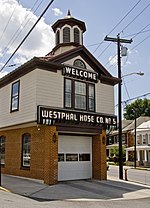Tuscarora Creek Historic District

Tuscarora Creek Historic District is a national historic district located near Martinsburg and Nollville, Berkeley County, West Virginia. It encompasses 31 contributing buildings and three contributing sites, related to the early settlement and economic development along the Tuscarora Creek. Notable buildings in the district include: Patterson's Mill (1765) and the miller's house, "Elm Dale," the Silber-Walters House, Huxley Hall, site of Patterson's New Mill and miller's house, Hibbard Mill, Tuscarora School, Providence Cemetery, the Mong House, Tuscarora Church (1802), James Noll Shop, Rumsey Mill site, and the poor house or "Mansion House" (1788).It was listed on the National Register of Historic Places in 1980.
Excerpt from the Wikipedia article Tuscarora Creek Historic District (License: CC BY-SA 3.0, Authors, Images).Tuscarora Creek Historic District
Meadowbrook Drive, Martinsburg
Geographical coordinates (GPS) Address Nearby Places Show on map
Geographical coordinates (GPS)
| Latitude | Longitude |
|---|---|
| N 39.469583333333 ° | E -77.968888888889 ° |
Address
Meadowbrook Drive 101
25401 Martinsburg
West Virginia, United States
Open on Google Maps









